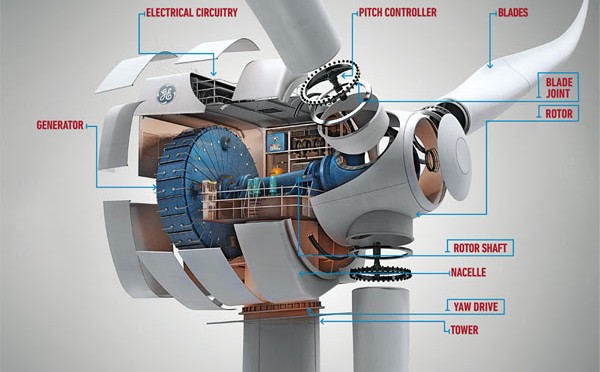One of the best ways to lower the cost of wind energy is simply to lower the cost of building the wind turbines. With that in mind, GE has partnered with Virginia Polytechnic Institute & State University and the National Renewable Energy Laboratory (NREL) to rethink the way wind blades are designed, manufactured, and installed.
The initial capital investments made in the wind turbines themselves account for most of the cost for electricity. With this new technology, the cost of electricity could lower the cost of wind-produced electricity dramatically. (And, notably, wind power already has the second-lowest median cost of electricity in the U.S., only behind hydropower.)
“GE’s weaving an advanced wind blade that could be the fabric of our clean energy future,” said Wendy Lin, a GE Principal Engineer and leader on the U.S. Department of Energy’s Advanced Research Projects Agency (ARPA-E) project. “The fabric we’re developing will be tough, flexible, and easier to assemble and maintain. It represents a clear path to making wind even more cost competitive with fossil fuels.”
GE is estimating that, with the new blade design, the price of wind energy could be reduced by 25% to 40%! The best part is that this is without using any government subsidies. Here are some more details from GE:
“GE’s research will focus on the use of architectural fabrics, which would be wrapped around a metal space frame, resembling a fishbone. Fabric would be tensioned around ribs which run the length of the blade and specially designed to meet the demands of wind blade operations. Conventional wind blades are constructed out of fiberglass, which is heavier and more labor and time-intensive to manufacture.
“Advancements in blade technology will help spur the development of larger, lighter turbines that can capture more wind at lower wind speeds. Current technology doesn’t easily allow for construction of turbines that have rotor diameters exceeding 120 meters because of design, manufacturing, assembly, and transportation constraints. Wider, longer wind blades are tougher to move and maneuver, and molds which form the clamshell fiberglass structure cost millions of dollars to acquire. GE’s new fabric-based technology would all but eliminate these barriers.”
One advantage to this new design is that components could be built and assembled on site, meaning design engineers no longer have to concern themselves with manufacturing and transportation limitations. If you added all this together, it means lower startup costs and a much lower cost of wind-generated electricity in general.
“It’s estimated that to achieve the national goal of 20% wind power in the U.S., wind blades would need to grow by 50% — a figure that would be virtually impossible to realize given the size constraints imposed by current technology. Lighter fabric blades could make this goal attainable,” the GE news release noted.
“Developing larger wind blades is the key to expanding wind energy into areas we wouldn’t think of today as suitable for harvesting wind power. Tapping into moderate wind speed markets, in places like the Midwest, will only help grow the industry in the years to come,” Lin stated.
Although this is a first for wind turbine blades, GE has begun using this space frame/tension fabric design in the construction of wind towers for better aesthetics, cost, and protection. The use of fabrics to improve cost-effectiveness and reduce weight dates back to World War I, when the military used them on airplanes.
“The $5.6M ARPA-E project will span three years. GE’s blade architecture will be built to achieve a 20 year life with no regular maintenance to tension fabrics required.”




